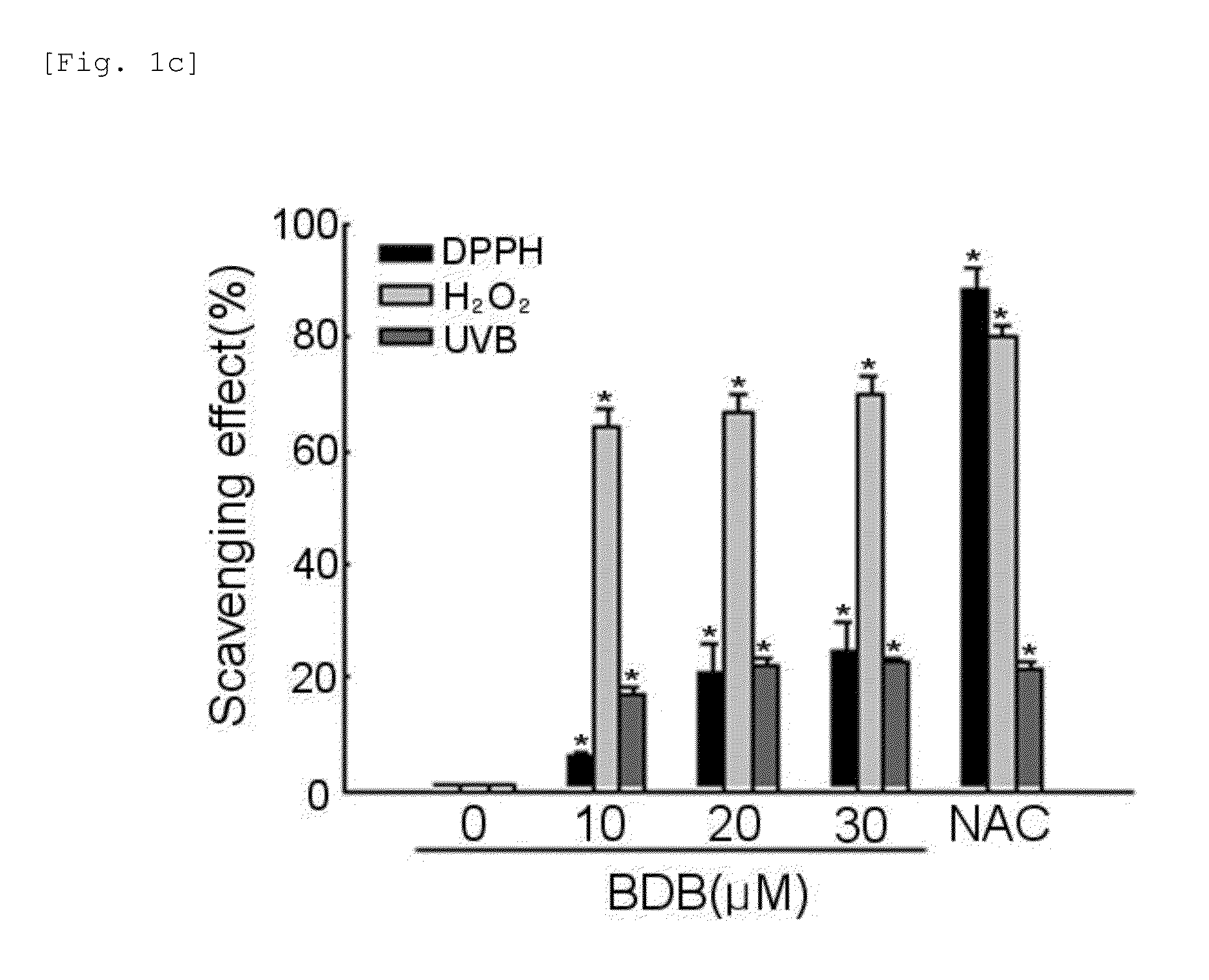Composition including 3-bromo-4,5-dihydroxybenzaldehyde compound as effective component for protecting and treating skin cell aganist ultraviolet
- Summary
- Abstract
- Description
- Claims
- Application Information
AI Technical Summary
Benefits of technology
Problems solved by technology
Method used
Image
Examples
example 1
[0077]Cell Culture
[0078]Human keratinocytes (HaCaT cells) were obtained from the Amore Pacific Company (Gyeonggi-do, Republic of Korea). Cells were maintained at 37° C. in an incubator with a humidified atmosphere of 5% CO2. Cells were cultured in Dulbecco's modified Eagle's medium containing 10% heat-inactivated fetal calf serum, streptomycin (100 μg / mL) and penicillin (100 unit / mL).
example 2
[0079]BDB Effectiveness on UVB-Induced Apoptosis
[0080]The effect of BDB on the viability of HaCaT cells was assessed as follows. Cells were seeded in a 96-well plate at a density of 1×105 cells / mL. Sixteen hours after plating, BDB was added at a concentration of at 10, 20, 30, 40, and 50 μM. To evaluate the ability of BDB to protect keratinocytes against UVB-exposure, BDB was added at a concentration of 10, and 30 μM, and cells were exposed to UVB radiation one hour later and incubated at 37° C. for 24 h. Fifty microliter of MTT stock solution (2 mg / mL) was added to each well to yield a total reaction volume of 200 μl. After incubating the cells for 4 h, the plate was centrifuged at 800×g for 5 min, and the supernatants were aspirated. The formazan crystals in each well were dissolved in dimethylsulfoxide (150 μl), and the absorbance at 540 nm was read on a scanning multi-well spectrophotometer.
[0081]As a result, the BDB does not exhibit toxicity on human HaCaT keratinocyte up to th...
example 3
[0082]Free Radical Removal Ability of BDB
[0083]DPPH radical removal ability and intracellular reactive oxygen species (ROS) removal ability were measured in order to confirm free radical removal ability of the BDB of the present invention prepared from Example.
[0084] Measurement of DPPH Radical Removal Ability
[0085]BDB at a concentration of 10, 20, 30 μM and 2 mM NAC were added to a 1×10−4 M solution of DPPH in methanol. The resulting reaction mixture was shaken vigorously. After 3 h, the amount of unreacted DPPH was measured at 520 nm using a spectrophotometer.
[0086]As a result, the BDB scavenged DPPH radical depending on the volume. As illustrated in a black bar in FIG. 1c, 10 μM of the BDB scavenged 6% of the DPPH radical, 20 μM of the BDB scavenged 21% of the DPPH radical, and 30 μM of the BDB scavenged 25% of the DPPH radical. Further, NAC (2 mM) that was known as a ROS scavenger and used as a positive control group scavenged 89%.
[0087] Measurement of Intracellular Reactive Oxy...
PUM
| Property | Measurement | Unit |
|---|---|---|
| Molar density | aaaaa | aaaaa |
| Molar density | aaaaa | aaaaa |
| Concentration | aaaaa | aaaaa |
Abstract
Description
Claims
Application Information
 Login to View More
Login to View More - R&D
- Intellectual Property
- Life Sciences
- Materials
- Tech Scout
- Unparalleled Data Quality
- Higher Quality Content
- 60% Fewer Hallucinations
Browse by: Latest US Patents, China's latest patents, Technical Efficacy Thesaurus, Application Domain, Technology Topic, Popular Technical Reports.
© 2025 PatSnap. All rights reserved.Legal|Privacy policy|Modern Slavery Act Transparency Statement|Sitemap|About US| Contact US: help@patsnap.com



